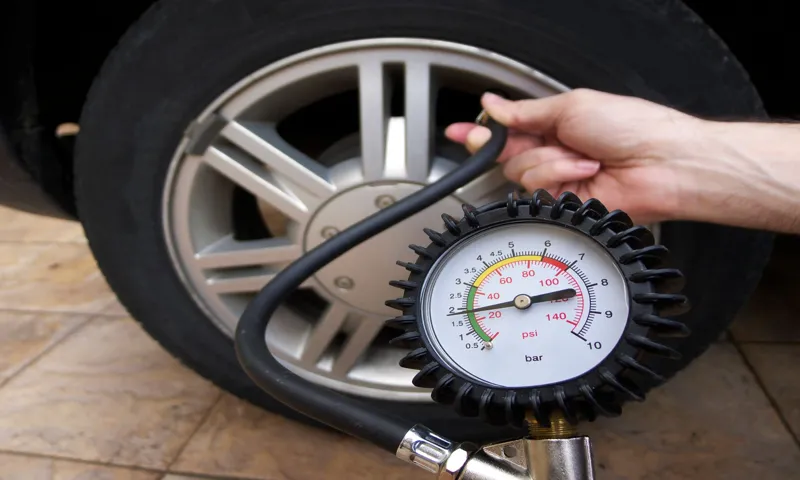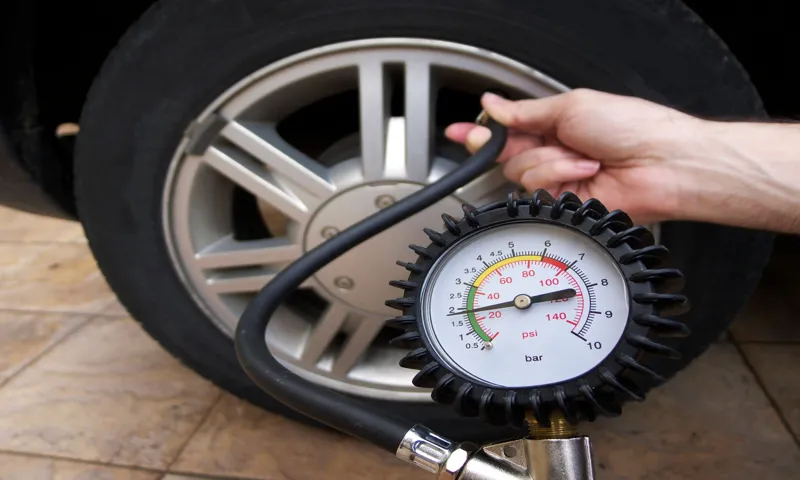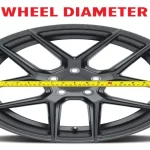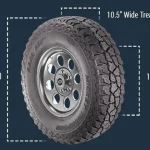Have you ever gone to check your tire pressure only to find that it’s lower than it was the last time? You might attribute it to a puncture or slow leak, but did you know that cold weather can also cause your tires to lose air? It’s a common phenomenon that catches many drivers off guard, but it’s important to understand why it happens and how to prevent it. In this blog post, we’ll dive into the science behind why tires lose air when it’s cold outside and provide you with tips to help keep your tires properly inflated all year round. So, let’s get started!
Table of Contents
Understanding Tire Pressure
Have you ever wondered why your tire loses air when it’s cold outside? Well, the answer lies in the science of tire pressure. As temperatures drop, the air molecules inside your tire begin to lose energy, causing them to move slower and take up less space. This decrease in volume leads to a drop in tire pressure, making your tires seem flat.
It’s important to check your tire pressure regularly, especially during colder months, to prevent any potential safety hazards on the road. In fact, for every 10-degree drop in temperature, your tires can lose up to 1 PSI of pressure. So, next time you notice your tire looking flat on a chilly morning, don’t fret! It’s just nature’s way of playing tricks on your tire pressure.
The Science of Air Temperature and Pressure
Understanding tire pressure is crucial for the safety and performance of a vehicle. Air temperature has a significant impact on tire pressure. As temperatures change, the air inside the tire expands or contracts, which can lead to fluctuations in pressure.
For example, in colder temperatures, the air inside the tire condenses, causing a decrease in pressure, while in warmer temperatures, it expands, resulting in an increase in pressure. In addition to temperature, several factors can affect tire pressure, including altitude, load weight, and the condition of the tire itself. Maintaining proper tire pressure can improve fuel efficiency, extend the life of tires, and ensure optimal handling and braking.
It is essential to check tire pressure regularly, especially during extreme temperature changes, and use a trustworthy tire pressure gauge to ensure accuracy. By understanding how temperature affects tire pressure, drivers can take the necessary steps to maintain safety on the road.

Effects of Cold Weather on Tire Pressure
Tire pressure is one of the most important aspects of car maintenance. It is directly linked to your vehicle’s safety and performance. Understanding tire pressure is essential, especially during the winter months when fluctuations in temperature can greatly affect your tires.
Cold weather has a significant impact on tire pressure, causing it to decrease. This is due to several factors, including the contraction of air molecules in low temperature, which results in a decrease in tire volume. Moreover, when the weather is cold, the air molecules in your tire move slowly and exert less pressure.
This leads to a decrease in tire pressure, which can cause risk on the road while driving. To keep your tires at the right pressure, it is important to regularly check your tire pressure during the winter months and to make sure the air pressure corresponds to the manufacturer’s specifications. By doing so, you ensure your vehicle’s safety, extend the life of your tires, and save money on fuel consumption.
Common Causes of Tire Pressure Loss in Cold Temperatures
Have you ever noticed that your car’s tire pressure seems to decrease when the temperature drops? Well, you’re not alone. Many drivers experience this common problem, wondering why their tire loses air when it’s cold outside. The reason has to do with the basic principles of physics.
As temperatures decrease, so does the air pressure inside your tires. This happens because the cold air causes the molecules in the tire to contract, lowering the overall pressure. Cold temperatures can also cause leaks in your tire, which leads to pressure loss.
In addition, many drivers neglect to check their tire pressure regularly and fail to maintain the appropriate levels, which can exacerbate the effects of cold weather. To prevent this problem, it’s crucial to check your tire pressure regularly, especially during colder months when the likelihood of pressure loss is higher. By keeping your vehicle’s tires properly inflated, you not only increase your safety on the road but also extend the life of your tires.
Leaky Valves and Damaged Rims
If you’re wondering why your tire pressure is dropping in cold temperatures, the answer may lie in leaky valves or damaged rims. These are two of the most common causes of tire pressure loss during winter months. Leaky valves can allow air to gradually escape from the tire, causing it to lose pressure over time.
Meanwhile, damaged rims can create small leaks that can also cause air to escape. It’s important to keep an eye on your tire pressure during cold weather and have any issues addressed promptly to prevent further damage. Think of it like patching a leak in a hose – ignoring the problem will only lead to bigger issues down the line.
Make sure to check your tire pressure regularly and address any problems as soon as you notice them to ensure safe and reliable driving.
Tire Tread Vulnerability to Cold Temperature
Winter weather can be tough on your tires, and even with proper maintenance, they can lose pressure and cause problems. One of the common causes of tire pressure loss in cold temperatures is the vulnerability of tire tread. When the temperature drops, tire rubber can become stiffer, making it more difficult for the tire to flex and adapt to the road.
As a result, the contact area and tire tread become less effective, leading to a decrease in tire pressure. This can be exacerbated by driving on rough roads or hitting potholes, which can damage the tire and accelerate pressure loss. To prevent this, it’s important to check your tire pressure regularly and keep them properly inflated.
Additionally, it’s crucial to make sure your tires have sufficient tread depth to maintain good traction on the road. A good analogy is to think of your tire tread as the shoes on your feet. Just like you wouldn’t want to walk around in old, worn-out shoes in the cold, you don’t want to drive on tires with insufficient tread in winter weather.
By taking these steps, you can keep your tires healthy and safe on the road all winter long.
Preventing Tire Pressure Loss in Cold Weather
Have you ever noticed that your tires seem to lose air pressure when the temperature drops? This is a common problem that many drivers experience during the winter months. The reason for this is simple: as the temperature drops, the air inside your tires contracts, causing a decrease in pressure. In fact, for every 10-degree drop in temperature, your tire’s air pressure can drop by as much as 1-2 PSI.
This may not sound like much, but it can have a significant impact on your vehicle’s handling and fuel efficiency. To prevent tire pressure loss in cold weather, it’s important to check your tire pressure regularly and keep your tires properly inflated. This will not only improve your vehicle’s performance but also extend the life of your tires.
So, the next time you notice your tire pressure dropping during the winter months, don’t panic. Simply check your tire pressure and inflate your tires to the recommended pressure levels to ensure safe and smooth driving.
Regular Tire Maintenance Practices
One of the most common issues with tires during cold weather is pressure loss. Fluctuations in temperature can cause the air inside tires to contract, resulting in lower pressure levels. The best way to prevent this is to regularly check your tires’ pressure and keep them properly inflated.
This can be done by using a tire pressure gauge to measure the pressure and adding air as needed. It’s also important to make sure your tires are in good condition and free of any punctures or damage that could cause further pressure loss. Proper tire maintenance not only helps prevent pressure loss but also improves overall safety and performance.
Always remember to check your tire pressure before long drives or when temperatures drop to ensure maximum tire performance. By taking these simple steps, you can reduce the risk of potential accidents and costly repairs caused by underinflated tires.
Best Practices for Cold Weather Driving
When the temperature drops, so can your tire pressure. In fact, for every ten-degree drop in temperature, your tire pressure can decrease by one to two PSI. This may not seem like a lot, but it can affect your handling and fuel efficiency.
To prevent tire pressure loss in cold weather, first make sure that your tires are properly inflated to begin with. Refer to your vehicle manual to find the recommended PSI for your tires. Then, check your tire pressure regularly during the winter months to ensure that it stays within the recommended range.
Additionally, consider investing in nitrogen fill for your tires, which can help to maintain pressure better than air. By taking these steps, you can ensure that your tires are up to the challenges of cold weather driving and keep yourself and your passengers safe on the road.
Final Thoughts
So, why does my tire lose air when it’s cold? The answer lies in physics. As temperatures drop, the air molecules inside the tire slow down, causing them to contract and reduce in pressure. This decrease in pressure may not be noticeable during warmer weather, but when the temperature drops dramatically, it can lead to a significant loss of pressure.
It’s essential to keep your tires properly inflated to ensure your safety on the road, especially during the colder months. A tire that’s underinflated is more susceptible to punctures, wears out faster, and reduces fuel efficiency. Therefore, it’s crucial to check your tire pressure regularly and maintain the recommended pressure levels, especially when preparing for a long drive during colder seasons.
By doing this, you could avoid unnecessary expenses on tire replacements and ensure optimal tire performance.
Conclusion
In summation, the reason why your tire loses air when it’s cold is simply due to the laws of physics! As the temperature drops, the air molecules inside the tire begin to lose energy and slow down, ultimately leading to a decrease in pressure. So, the next time you feel that telltale flat tire sensation on a frosty morning, just remember: It’s not you, it’s science!”
FAQs
What is the reason behind the decrease in tire pressure during cold weather?
Tire pressure tends to decrease in cold temperatures because the air inside the tires compresses and becomes denser, resulting in a lower tire pressure.
What is the ideal tire pressure for my vehicle during cold weather?
It’s recommended to follow the manufacturer’s recommended tire pressure. However, during the winter, add one or two PSI (pounds per square inch) more to compensate for the drop in pressure caused by the cold weather.
How often should I check my tire pressure during winter?
It’s advisable to check your tire pressure regularly, at least once a month during the cold season, and preferably before every long trip.
Is it important to maintain the correct tire pressure during winter?
Yes, maintaining the correct tire pressure is essential for safe driving and improving fuel efficiency. Low tire pressure can lead to decreased traction, poor handling, and increased risk of accidents.
Can underinflated or overinflated tires affect my fuel economy during the winter?
Yes, underinflated tires increase surface contact and rolling resistance, resulting in excessive fuel consumption. Overinflated tires have poor traction and cause wear on the center of the tread, which also impacts fuel efficiency.
How can I prevent my tire pressure from dropping during the cold weather?
You can reduce air pressure loss by installing winter or all-season tires that are designed to maintain air pressure under cold weather conditions. Additionally, you can store your car indoors or in a warm garage to negate the effect of cold weather.
What should I do if my tire pressure drops suddenly during the winter?
If your tire pressure drops rapidly, check for punctures or any damage that may have led to the sudden pressure loss. If you can’t find any visible damage, take your vehicle to an auto repair shop for further inspection.



